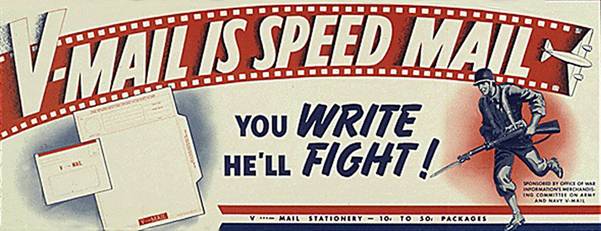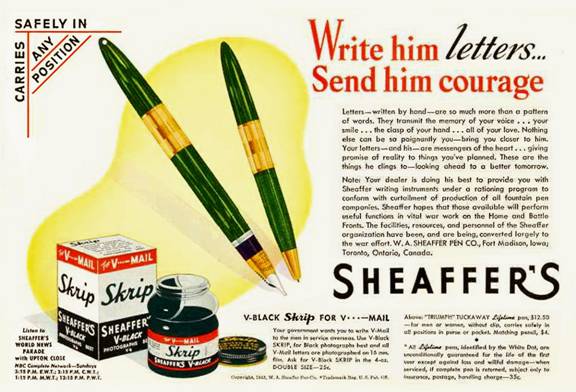From Fountain Pen to Paper, via Microfilm
You write letters to someone in uniform, and as the war permits, you get letters from that someone in return. Occasionally, the censor blacks out a few words, but you still get the letters, and that means a lot. It's funny how a simple thing like getting a letter can make such a difference.
Except that delivering wartime mail was far from simple. More than 16 million Americans served during the war, in a great variety of countries, and they all received and sent letters. On any given day, millions of letters, likely weighing in total hundreds of tons, were in transit. Getting them to their destinations took sweat, aircraft, ships, trains, trucks, fuel, and rubber - all of which were in short supply to the fighting forces. Something had to give.
Before the war, Great Britain had worked with Eastman Kodak and international airlines to devise a system that greatly reduced the impact of mail on air cargo resources. The U.S. was able to advance, or at least adapt, that system for its wartime needs. It called its version V-Mail.

Makes it sound like Cause and Effect, doesn't it?
poster illustrating V-Mail stationery
veteran-voices.com
In 1942, the fountain pen was as ubiquitous as the cell phone is today. Thus, one constraint which V-Mail respected was that Americans, whether at home or at war, would continue to write letters using their fountain pens. A corollary was that the letters they received would appear "as written" (i.e., in the familiar handwritings of those who had sent them). As the illustration above suggests, for the sake of morale, it was essential that the recipient immediately recognized the sender's handwriting, and felt the connection it triggered. How did it work?
V-Mail letters had to be written on special stationery. Any fountain pen could be used, as long as it was filled with an opaque black ink. When mailed, the letter first was routed to the closest military post office facility. There, it was reviewed by censors, and sorted according to where the recipient was currently stationed. All V-Mail letters that were headed to the same military post office were gathered together for microfilming. Once developed, the reel of 16mm film was packaged, labeled, and forwarded. The receiving APO (at that time, military post offices were all called Army Post Offices) had equipment that printed all the spooled microfilmed V-Mail. The resulting paper letters, somewhat smaller than the originals, were then dispatched for delivery. The process for letters written home from the front was the same.
The hand-written paper V-Mail letters were retained until the sending APO was notified they had been delivered. If a roll of microfilm was lost or damaged before its letters could be delivered, the originals were re-microfilmed, and the process repeated.
One mailbag of microfilm reels was the equivalent of perhaps 40 bags of regular mail, and weighed only about 2% of the equivalent paper. Considering the great distances many letters had to travel, the fuel savings were immense.
*
Meanwhile, an independent but parallel problem had arisen. In effect, every U.S. soldier used a fountain pen, but old Army regulations made it hard to carry one if you were in uniform: the flap on your shirt pocket had to be buttoned closed. If you clipped your pen in your pocket - a necessity for almost all fountain pens, which had to be stored upright to prevent their nibs from clogging - the flap would not close properly. Thus, pen-makers had to redesign their pens and mechanical pencils because of the war.

Because of the big flap about pocket-flaps, some pen companies designed
top-mounted "military clips" that permitted flaps to be closed over them.
Instead, Sheaffer's eliminated clips, and modified the ink flow mechanism
so that nibs would not clog, regardless of how their new pens were stored.
Note the terminology: V-Mail referred to Victory,
and the new Sheaffer model was the Triumph
advertisement in National Geographic, May 1943
***

